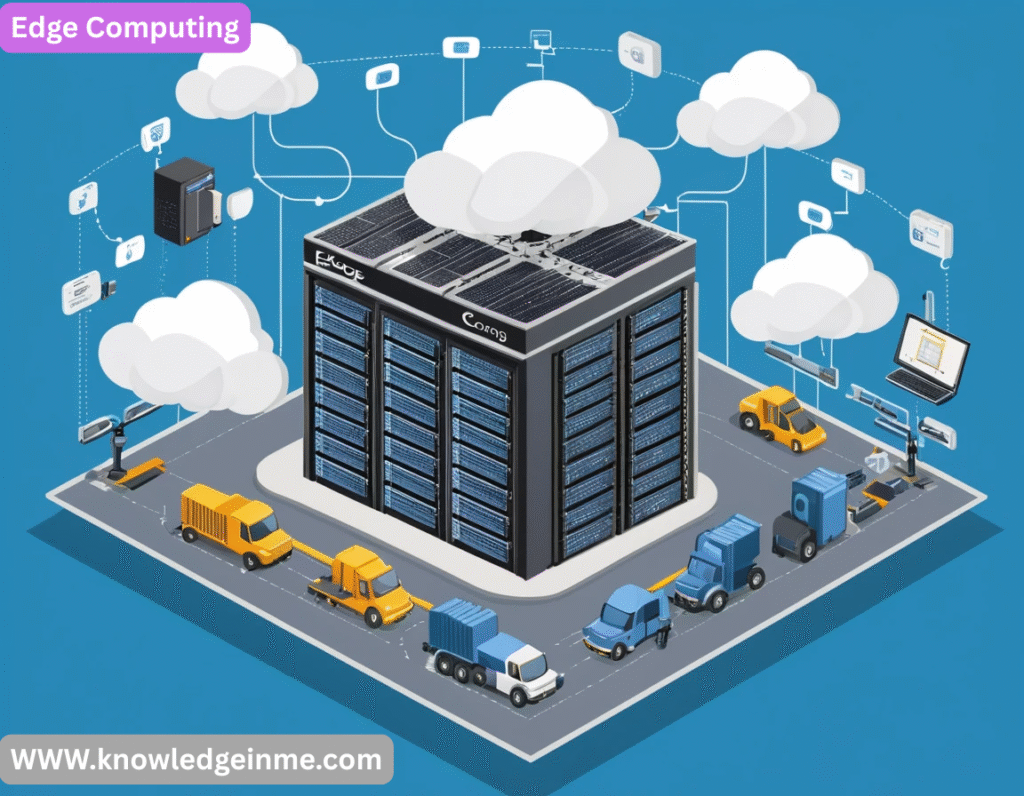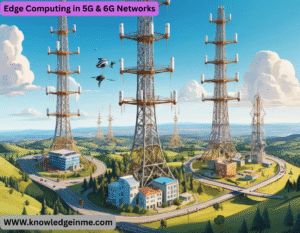Edge computing is a distributed computing paradigm that brings data processing and storage closer to the source of data generation (e.g., IoT devices, sensors, or end-users) rather than relying on a centralized cloud data center. This reduces latency, bandwidth usage, and reliance on cloud servers, enabling faster and more efficient real-time processing.
Key Characteristics of Edge Computing
- Low Latency: By processing data locally or at nearby edge nodes, response times are significantly reduced.
- Bandwidth Efficiency: Minimizes the need to send large volumes of raw data to the cloud.
- Real-Time Processing: Enables instant decision-making for applications like autonomous vehicles and industrial automation.
- Decentralization: Distributes computing power across multiple edge devices instead of relying on a central cloud.
- Enhanced Privacy & Security: Sensitive data can be processed locally, reducing exposure to breaches during transmission.
How Edge Computing Works
- Local Processing: Data is processed at the edge device (e.g., a smart camera, router, or gateway) or a nearby edge server.
- Action or Transmission: Only relevant data (e.g., alerts or insights) is sent to the cloud for further analysis.
Edge vs. Cloud vs. Fog Computing
Feature Edge Computing Cloud Computing Fog Computing
Location Closest to data source (device level) Remote data centers Between edge and cloud (network layer)
Latency Ultra-low (~MS) High (100s of MS) Moderate
Use Case Real-time apps (autonomous cars, AR/VR) Big data analytics, long-term storage Industrial IoT, smart cities
Applications of Edge Computing
- Autonomous Vehicles: Instant processing of sensor data for real-time navigation.
- Smart Cities: Traffic management, surveillance, and utility monitoring.
- Healthcare: Wearable devices for real-time patient monitoring.
- Industrial IoT (LLOT): Predictive maintenance in factories using machine learning at the edge.
- Retail: Personalized in-store experiences via edge AI.
- AR/VR & Gaming: Reduced lag for immersive experiences.
Advantages of Edge Computing
- Faster response times (critical for robotics, drones, and medical devices).
- Reduced cloud costs (less data transmission = lower bandwidth expenses).
- Improved reliability (works even with intermittent cloud connectivity).
- Enhanced security (local processing reduces attack surfaces).
Challenges & Limitations
- Higher upfront costs (deploying edge infrastructure can be expensive).
- Management complexity (requires distributed system expertise).
- Limited scalability compared to cloud computing.
- Security risks (edge devices may be physically vulnerable).
Edge Computing Architecture
Edge computing involves multiple layers between end devices and the cloud:
Three-Tier Edge Architecture
Device Edge (Endpoints)
- Sensors, cameras, smartphones, wearables, and IoT devices.
- Limited processing power; often sends raw data to nearby gateways.
- Local Edge (Gateways & Micro Data Centers)
- Edge servers, routers, or on-premise servers.
- Performs initial data filtering, preprocessing, and real-time analytics.
- Cloud Edge (Regional Data Centers)
- Handles heavier computations and long-term storage.
Fog Computing vs. Edge Computing
Edge Computing processes data directly on the device or a nearby server.
Aspect Edge Computing Fog Computing
Processing Location On-device or nearby edge server Distributed across network nodes
Latency Ultra-low (milliseconds) Low (slightly higher than edge)
Use Case Autonomous vehicles, real-time AR Smart grids, industrial IoT
Key Technologies Enabling Edge Computing
5G Networks
- Provides ultra-low latency (<1ms) and high bandwidth, crucial for edge applications.
- Enables network slicing (dedicated virtual networks for different services).
AI at the Edge Edge AI
- Machine learning models deployed directly on edge devices (e.g., facial recognition in cameras).
Benefits:
- Faster inference (no cloud dependency).
- Privacy-preserving (data stays local).
Kubernetes & Containerization
- Kubernetes for Edge (KUBE Edge, MicroK8s) helps manage distributed edge applications.
- Containers (Docker) allow lightweight deployment of edge services.
Server less Edge Computing
- Functions-as-a-Service (FAAS) at the edge (e.g., AWS Lambda @Edge, Cloud flare Workers).
- Reduces infrastructure management overhead.
Security & Privacy Challenges in Edge Computing
Major Security Risks
- Physical Attacks – Edge devices (e.g., cameras, sensors) can be tampered with.
- Data Integrity – Ensuring data isn’t altered during local processing.
- Network Vulnerabilities – Man-in-the-middle (MITM) attacks in distributed networks.
- AI Model Poisoning – Adversarial attacks on edge AI models.
Mitigation Strategies
- Zero Trust Architecture – Strict access controls for edge devices.
- Hardware-Based Security (TPM, Secure Enclaves) – Protects encryption keys.
- Federated Learning – AI training without exposing raw data.
- Blockchain for Edge – Ensures tamper-proof logs in decentralized networks.
Edge Computing in Industry 4.0 & IoT
Industrial IoT (LLOT) & Smart Factories
- Digital Twins – Real-time virtual models of physical systems.
Healthcare LOMT – Internet of Medical Things
- Wearables & Remote Monitoring – ECG, glucose monitors process data locally.
- AI Diagnostics – On-device analysis of X-rays/MRI scans for faster decisions.
Autonomous Vehicles & Smart Transportation
- Real-Time Object Detection – Edge AI processes LiDAR/camera data instantly.
Retail & Smart Cities
- Cashier less Stores (Amazon Go) – Edge AI tracks purchases without cloud delays.
- Traffic Management – Cameras and sensors optimize traffic flow in real-time.
Future Trends in Edge Computing
- AI-Driven Edge Automation – Self-optimizing edge networks using reinforcement learning.
- Quantum Edge Computing – Quantum processors for ultra-fast edge computations (still experimental).
- Edge-Cloud Continuum – Seamless workload shifting between edge and cloud.
- 6G & Advanced Edge Networks – Expected to further reduce latency and enhance edge capabilities.
Advanced Edge Computing Architectures
Hierarchical Edge Computing Models
Device-Level Edge
- Example: Smartphones, embedded sensors, Raspberry Pi
- Capability: Basic filtering, lightweight ML inference
- Limitation: Minimal compute power
Gateway Level Edge
- Example: Industrial PCs, edge servers (NVIDIA Jetson, AWS Snow cone)
- Capability: Aggregates data, runs real-time analytics
On Premise Edge Data Centers
- Example: Microsoft Azure Stack Edge, IBM Edge Application Manager
- Capability: Near-cloud performance for latency-sensitive apps
Regional Edge Cloud Edge
- Example: AWS Local Zones, Google Distributed Cloud
- Role: Acts as a middle layer before full cloud processing
Emerging Architectures
- Mobile Edge Computing (MEC) – 5G towers with built-in compute (ETSI standard)
- Swarm Computing – Collaborative edge devices (e.g., drone networks)
Edge AI Machine Learning at the Edge
Why Run AI on Edge Devices
- Latency: Autonomous cars can’t wait for cloud responses (~200ms vs ~5ms at edge)
- Bandwidth: A single smart factory generates terabytes/day—only 10% needs cloud upload
- Privacy: Medical/Face recognition data stays local (GDPR/HIPAA compliant)
Popular Edge AI Frameworks
Framework Use Case Hardware Support
Tensor Flow Lite Mobile/Embedded ML ARM, Raspberry Pi, Coral TPU
PY Torch Mobile On-device AI training iOS/Android, NVIDIA Jetson
ONNX Runtime Cross-platform AI Intel Open VINO, Qualcomm SNPE
Apache TVM Optimized ML for edge Xilinx FPGAs, AWS Inferentia
Edge AI Use Cases
- Predictive Maintenance – Vibration sensors detect machine failures early
- Federated Learning – Hospitals train AI models without sharing patient data
- Autonomous Drones – Real-time obstacle avoidance without cloud dependency
Security Deep Dive: Protecting the Edge
Defense Mechanisms
- Hardware Roots of Trust
- Secure Enclaves (Apple T2, Intel SGX)
- Trusted Platform Module (TPM) for encryption
Blockchain for Edge Integrity
- IBM’s Hyper ledger Fabric for tamper-proof logs
- IOTA Tangle for lightweight IoT transactions
- Zero Trust Edge (ZTE)
- Continuous device authentication
- Micro-segmentation (Google Beyond Corp model)
Edge Computing in 5G & 6G Networks
How 5G Supercharges Edge Computing
- Ultra-Reliable Low Latency (URLLC): <1ms latency (critical for robotics, AR/VR)
- Network Slicing: Dedicated virtual networks for different services
- Multi-Access Edge Computing (MEC): Compute inside 5G base stations
6G and the “Intelligent Edge” (2030+)
- AI-Native Networks: Self-optimizing edge clouds
- Terahertz (THz) Communication: 100x faster than 5G
- Holographic Edge: Real-time 3D holograms (telemedicine, metaverse)
The Future: What’s Next for Edge
Merging Edge with Quantum Computing
- Quantum Edge Nodes (IBM, Google experimenting)
- Post-Quantum Cryptography for edge security






